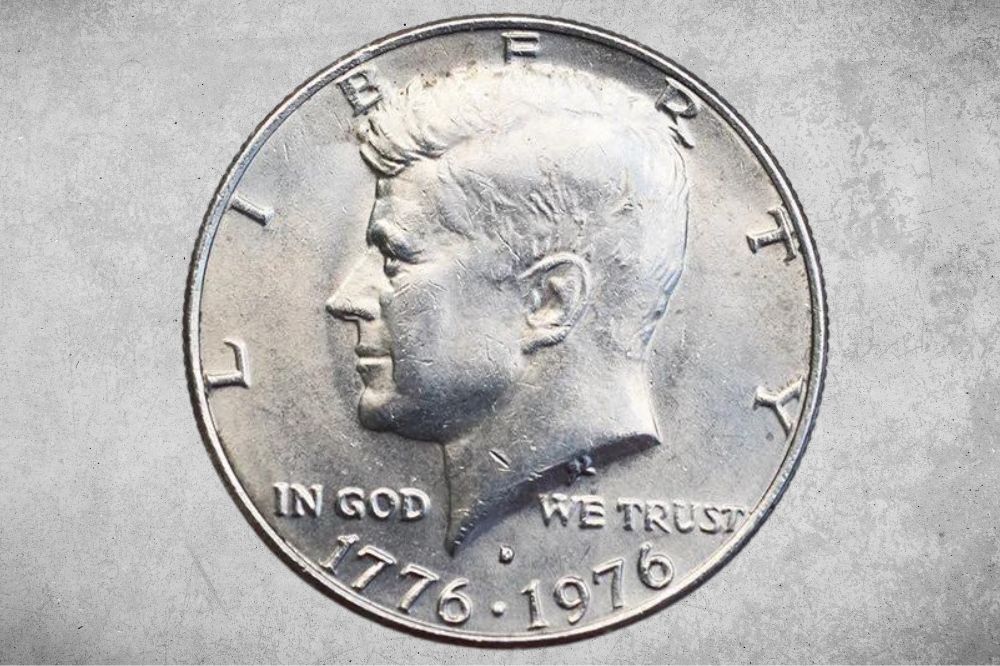You may be wondering why your coin has two dates on it. Well, that’s because it’s a bicentennial coin. And believe it or not, this coin could be worth more than just 50 cents. In this article, we’ll tell you exactly why by providing you with everything you need to know about this particular coin, including its value chart, variety, history, errors, and more. So, let’s get started with the adventure of the 1976 half dollar value!
1976 Half Dollar Value Details
- Category: Kennedy Half Dollar
- Mints: Philadelphia, Denver, San Francisco
- Total Mintage: 539,932,347
- Obverse Design: John F. Kennedy
- Reverse Design: Independence Hall
- Designer: Gilroy Roberts(obverse); Seth Huntington (reverse)
- Composition: 75% copper; 25% nickel / 80% silver; 20% copper / Composite layers; 40% silver
- Diameter: 30.6 mm (1.20 inches)
- Mass: 11.34 grams
- Thickness: 2.15 mm (0.084 inches)
- Edge: Reeded
- ASW: 0.36169 oz
1976 Half Dollar Value Chart
|
1976 Half Dollar Value Chart |
|||||
| Mint Mark | MS63 | MS64 | MS65 | MS66 | MS67 |
| 1976 No Mint Mark Clad Half Dollar Value |
$1.50 |
$4.05 |
$13.50 |
$130 |
$1,620 |
| 1976 D Clad Half Dollar Value |
$1.50
|
$4.05 |
$27 |
$33.75 |
$1,020 |
| 1976 S Silver Half Dollar Value |
$7.22 |
$9.92 |
$20.25 |
$27 |
$37.80 |
|
1976 S Proof Half Dollar Value |
|||||
| PR66 | PR67 | PR68 | PR69 | PR70 | |
| 1976 S Clad Half Dollar Value |
$6.75 |
$8.10 |
$10.80 |
$14.85 |
– |
| 1976 S Clad Half Dollar Value (CAM) |
$9.45 |
$10.80 |
$12.15 |
$14.85 |
$228 |
| 1976 S Clad Half Dollar Value (DCAM) |
$12.15 |
$13.50 |
$14.85 |
$20.25 |
$364 |
| 1976 S Silver Half Dollar Value |
$12.15 |
$14.85 |
$17.55 |
$27 |
– |
| 1976 S Silver Half Dollar Value (CAM) |
$13.50 |
$16.20 |
$18.90 |
$29.70 |
$162 |
| 1976 S Silver Half Dollar Value (DCAM) |
$16.20 |
$18.90 |
$21.60 |
$35.10 |
$325 |
1976 Half Dollar Value and Varieties Guide
1976 No Mint Mark Half Dollar Value
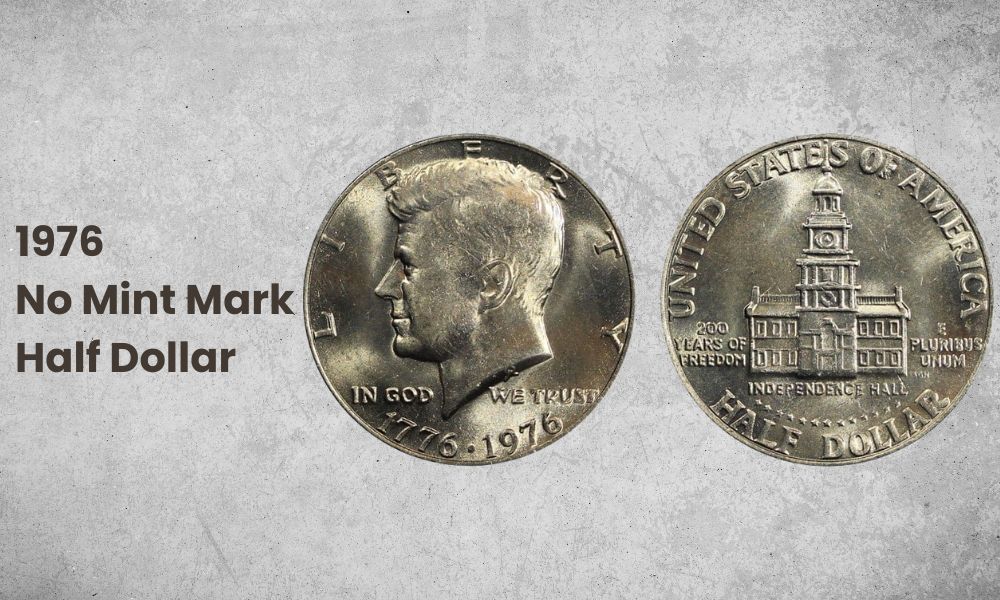
- Type: Kennedy Half Dollar
- Edge: Reeded
- Mint mark: None
- Place of minting: Philadelphia
- Year of minting: 1976
- Face value: $0.50
- $ Price: $1.50to $1,620
- Quantity produced: 234,308,000
- Designer: Gilroy Roberts(obverse); Seth Huntington (reverse)
- Composition: 75% copper; 25% nickel
The Kennedy Half Dollar coin from 1976 that doesn’t have a mint mark on it was made at the Philadelphia mint and has a reeded edge. It was designed by Gilroy Roberts and Seth Huntington and comprises 75% copper and 25% nickel. The rarity of this coin makes it worth anywhere from $1.50 to $1,620, depending on its condition.
In 2017, a rare 1976 Clad Kennedy Half Dollar coin was sold for $2,232 at an auction by Heritage Auctions. The coin was double-struck, with the second strike being 40% off-center, and was graded MS66 by NGC. Another 1976 50C Clad Kennedy Half Dollar, graded MS67 by PCGS, was sold for $1,998 at the same auction house in 2014.
1976 D Half Dollar Value
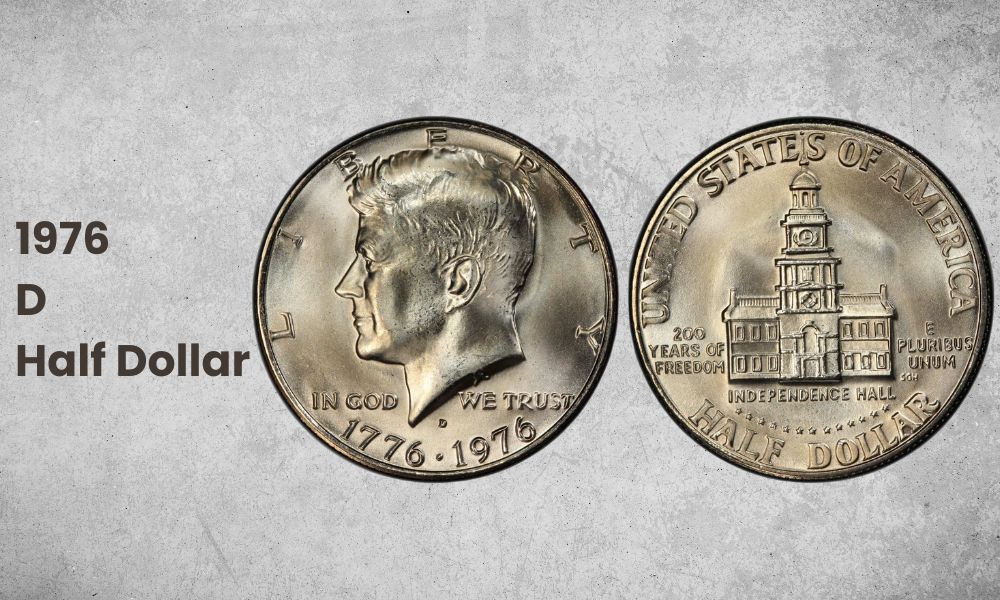
- Type: Kennedy Half Dollar
- Edge: Reeded
- Mint mark: D
- Place of minting: Denver
- Year of minting: 1976
- Face value: $0.50
- $ Price: $1.50to $1,020
- Quantity produced: 287,565,248
- Designer: Gilroy Roberts(obverse); Seth Huntington (reverse)
- Composition: 75% copper; 25% nickel
On January 12, 2014, a 1976 D Half Dollar (MS67+) was sold at auction by Heritage Auctions for $2,585, which is the highest price paid for this specific coin in an auction setting. In the case of this particular coin, its high grade and commemorative nature likely contributed to its value. Also, let’s not dismiss the fact that it was sold in a public auction where multiple bidders competed, for it could have also driven up this 1976 Half Dollar value.
1976 S Silver Half Dollar Value
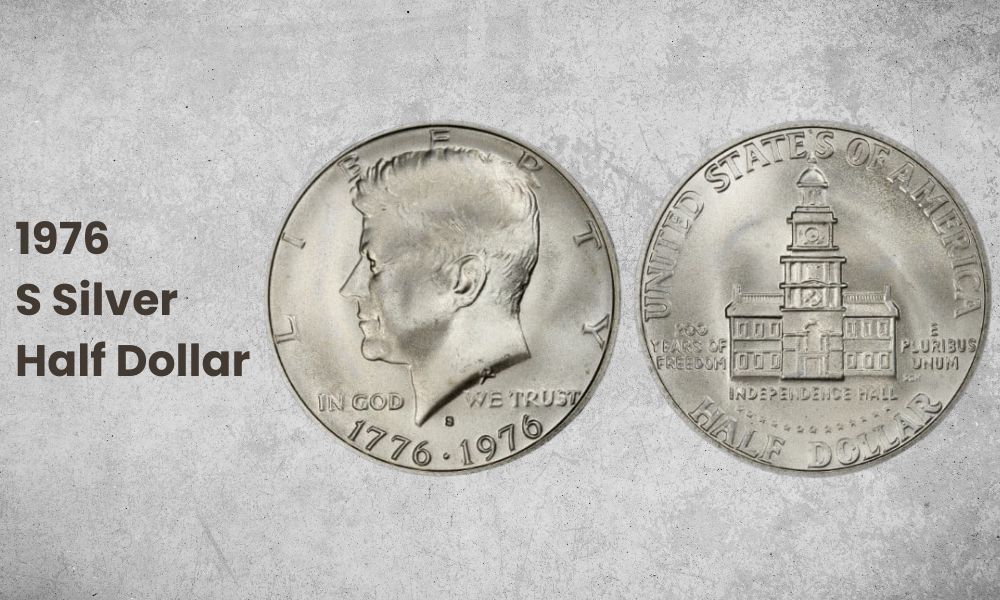
- Type: Kennedy Half Dollar
- Edge: Reeded
- Mint mark: S
- Place of minting: San Francisco
- Year of minting: 1976
- Face value: $0.50
- $ Price: $7.22to $37.80
- Quantity produced: 11,000,000
- Designer: Gilroy Roberts(obverse); Seth Huntington (reverse)
- Composition: 80% silver; 20% copper
- ASW: 0.36169 oz
The 1976 S Silver Half Dollar is part of a special set that includes a silver dollar, a half dollar, and a quarter, all featuring a special design commemorating the anniversary. All bicentennial half dollars from Philadelphia and Denver were struck in copper nickel.
The San Francisco Mint produced a silver variety of the 1976 half dollar with different variations. One of them is this 1975 silver half dollar with 80% silver and 20% copper. One piece of this coin was sold for $9,600 at a Heritage Auctions event in August 2022. Its high grade of MS69 is also unusual.
1976 S Clad/Silver Proof Half Dollar Value
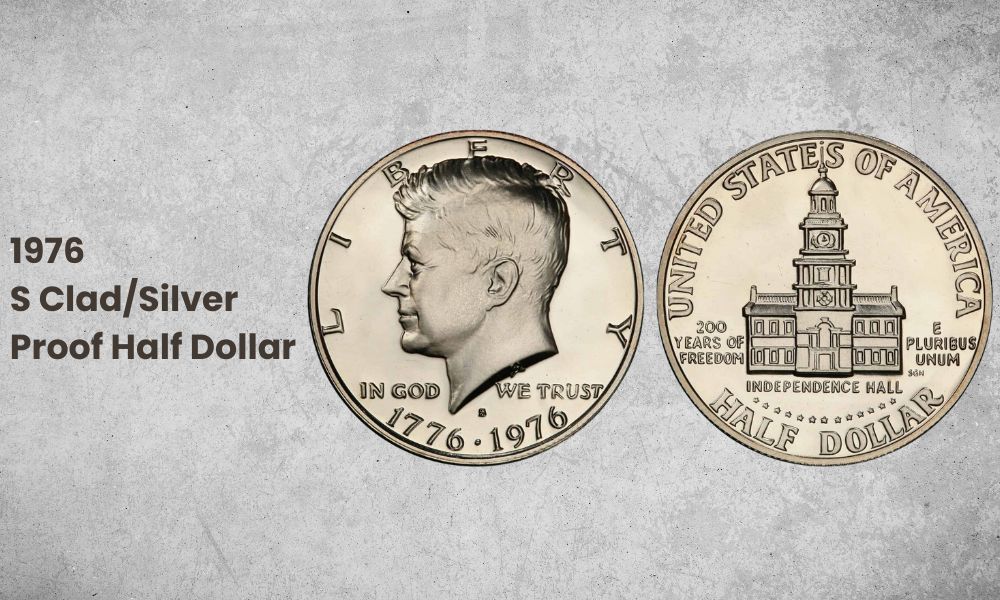
- Type: Kennedy Half Dollar
- Edge: Reeded
- Mint mark: S
- Place of minting: San Francisco
- Year of minting: 1976
- Face value: $0.50
- $ Price: $6.75to $364
- Quantity produced: 7,059,099
- Designer: Gilroy Roberts(obverse); Seth Huntington (reverse)
- Composition: 75% copper; 25% nickel / Composite layers; 40% silver
- ASW: 0.1472 oz
There are two types of the 1976 S Proof Half Dollar, which differ in composition. The first type is made of 40% silver, also known as the 1976 S 40% Silver Kennedy Half Dollar. The second type is made of 75% copper and 25% nickel and is also known as the 1976-S Copper-Nickel Clad Kennedy Half Dollar or the 1976 S Proof Bicentennial Kennedy Half Dollar. The 1976 S Silver Proof Half Dollar is considered a silver coin, while the 1976 S Clad Proof Half Dollar is not.
The highest-selling 1976 S Clad Proof Half Dollar was a PR70 Deep Cameo PCGS graded coin, which means it was in perfect condition with no visible flaws and had a highly contrasted frosted cameo finish. It was sold for $900 in June 2020 at Heritage Auctions.
On the other hand, the highest-selling 1976 S Silver Proof Half Dollar was a coin struck on a five-cent planchet, which means that it was minted using a blank meant for a nickel instead of a half dollar. This error coin was graded PR63 by PCGS, indicating that it was in nearly perfect condition with only minor imperfections. It was sold for $4,465 on January 9, 2017, at Heritage Auctions.
Also Read: Top 15 Most Valuable Kennedy Half Dollar Worth Money
1976 Half Dollar Value History
After the assassination of President John F. Kennedy in 1963, Congress decided to redesign the half dollar to honor him. Thus, the Kennedy Half Dollar Series began in 1964 and has been in circulation ever since.
Proof Kennedy half dollars were initially made of 90% silver, but due to the rising silver prices, these coins were not widely circulated, and many were melted down. In 1965, the US Mint later modified the silver percentage to address the issue, making it a 40% silver and 60% copper composition.
One example of Kennedy Half Dollars with unique variations is the 1964 Heavily Accented Hair Half Dollar and some from the 1960s and early 1970s. They are considered to be the most valuable half dollar. In addition, in 2014, the West Point Mint produced a particular gold-proof Kennedy Half Dollar to commemorate the series’ 50th anniversary.
In 1971, copper-nickel-clad proofs were introduced, and in 1975 and 1976, the design was updated to celebrate the nation’s bicentennial. But for some reason, some of these were removed from everyday use, although they remained in circulation until 2002. While there are no particularly rare issues of the Kennedy Half Dollar, some varieties (MS66 & MS67) are scarce.
As for the case of the 1975-1976 bicentennial Kennedy half-dollar, the coin was created to celebrate the 200th anniversary of America’s independence. The obverse side of the coin has a picture of President John F. Kennedy’s profile, made by the artist Gilroy Roberts. You’ll also see the words “LIBERTY” and “IN GOD WE TRUST” surrounding Kennedy’s profile and the dual date 1776-1976.
On the reverse side, another artist, Seth G. Huntington, changed the original design of the heraldic eagle clutching arrows and an olive branch. As this is a unique coin production to celebrate America’s independence, Huntington’s temporary reverse design shows Independence Hall, a famous building in Philadelphia where the Declaration of Independence was signed. You’ll also see the words “INDEPENDENCE HALL,” “UNITED STATES OF AMERICA,” “HALF DOLLAR,” “200 YEARS OF FREEDOM,” and “E PLURIBUS UNUM” with SGH initials.
If you look closely at the rim, the coin has an S or D mint mark, depending on where it was struck. If none of these marks, the 1976 Half Dollar was minted in Philadelphia.
The San Francisco Mint struck two different compositions of this series compared to the standard 75% copper and 25% nickel of the Philadelphia and Denver Mints. The 1976 S Clad Half Dollars were made of 80% silver and 20% copper, but they reduced the silver percentage to 40% for the proof variety of this coin, and the rest are composite layers.
1976 Half Dollar Value Grading
Numismatists use the Sheldon Scale to grade coins on a scale of P-1 to MS-70 based on their condition. This system was established in the 1970s to create a more objective grading system, replacing previously used subjective terms. The grades are based on wear, design elements, luster, and eye appeal. Mint State Perfect is the highest grade possible, indicating a coin with no visible imperfections.
To better understand this, watch this video where The Potter’s Stackers described how to grade a 1976 Half Dollar value and the other half dollars minted in the US.
List of 1976 Half Dollar Value Errors
1. 1976 Half Dollar Off-center Error
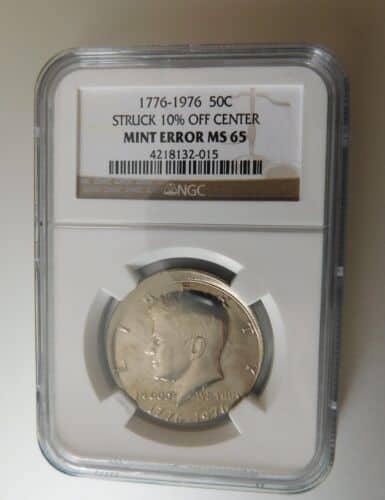
The 1976 Half Dollar off-center error happened when the coin was struck away from its center point, making it look irregular. This is different from a broadstrike where the punch lands at the coin’s center. The off-center error shows a blank space on the coin, making it look unusual and abnormal. A minimum range for this 1976 Half Dollar error is $100.
See this off-center error from the Couch Collectibles review of a rare 1976 Half Dollar value from the video below.
2. 1976 Half Dollar Misaligned Die Strike Error
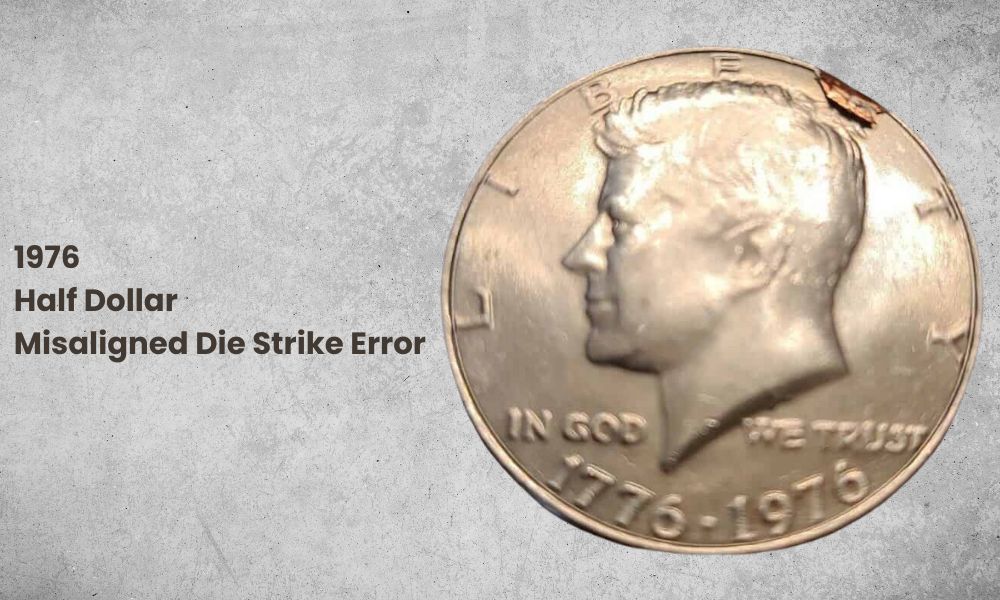
At a coin convention at the Michigan State Numismatic Society, a retired banker brought a pair of Bicentennial half dollar coins to a table. One of the coins had a more than 10% misaligned die strike, a rare and impressive error. According to an expert in error coin collecting, this was the largest and most significant error they had ever seen on a bicentennial half dollar.
Misaligned die errors happen when one of the coin-making dies gets out of place during minting. This usually happens to the upper hammer die, which makes the obverse look like it’s not in the middle. But you’ll see that the reverse is still in the right spot. Sometimes, the opposite happens, where the reverse looks off-center instead. These errors are only noticeable when you flip the coin and compare both sides.
3. 1976 Half Dollar Wrong Planchet Error
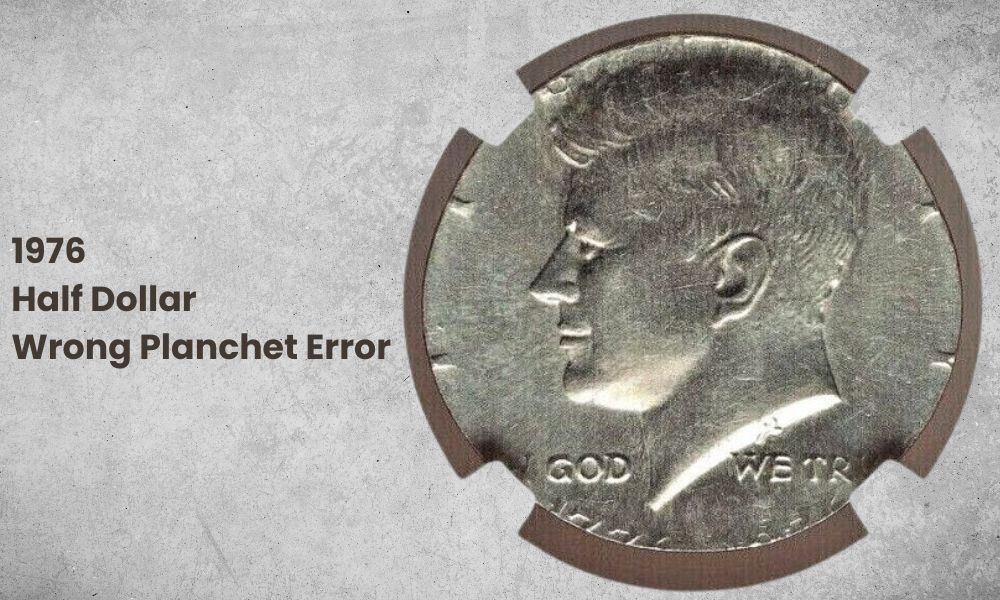
A wrong planchet error in a 1976 Half Dollar occurs when a coin is struck with an unexpected characteristic not intended during the minting of this coin. In this case, the error is that a 1976 Bicentennial Kennedy Half Dollar was struck on a quarter planchet.
A planchet is a blank piece of metal used to make a coin. In this case, a quarter planchet was mistakenly used instead of the proper half dollar planchet. This resulted in a coin that is the same size and weight as a quarter but with a Kennedy Half Dollar design. According to the PCGS, this particular error was $3,105.
4. 1976 Half Dollar Double Struck Error
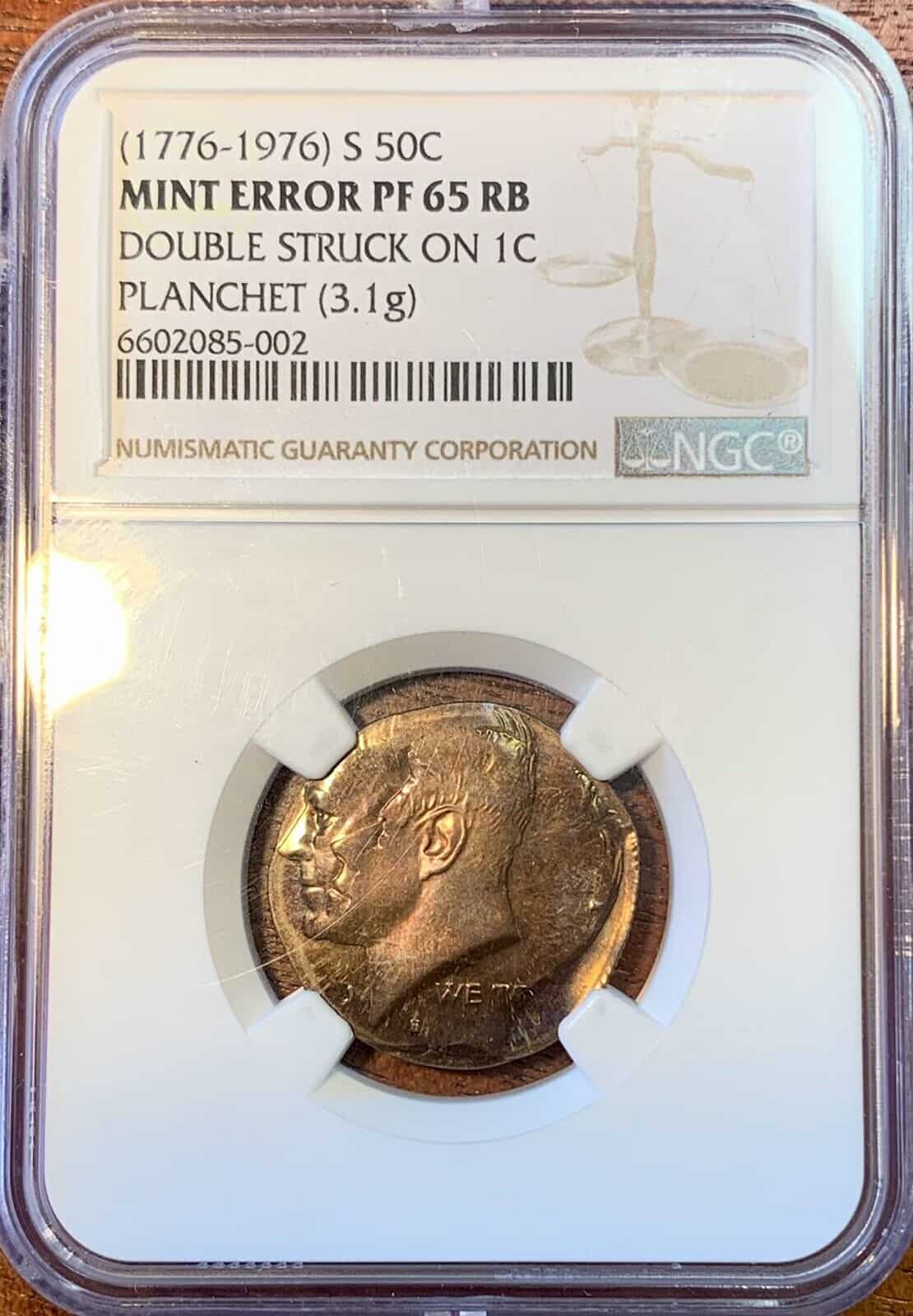
In this 1976 Half Dollar value error, a piece of metal was missing, and this mistake is known as an incomplete planchet. It happened because a curved clip got accidentally cut out of the coin during production. To be clear, it wasn’t a result of a faulty strike but a mistake that happened while the coin was being made. Some folks call this error an “end clip,” but its proper name is actually an incomplete planchet.
1976 Half Dollar Value FAQ
What makes a 1976 half dollar rare?
Except for the unique dual date on the obverse design, the 1975 and 1976 Half Dollars were distinctive as they featured the image of Independence Hall in celebration of America’s independence.
Not only that but despite a large number of these coins being produced, only a small number were struck to an exceptionally high standard of brilliance (proof strikes), making them exceptionally rare and desirable. As a result, these coins hold a greater value than the standard ones commonly seen in circulation.
